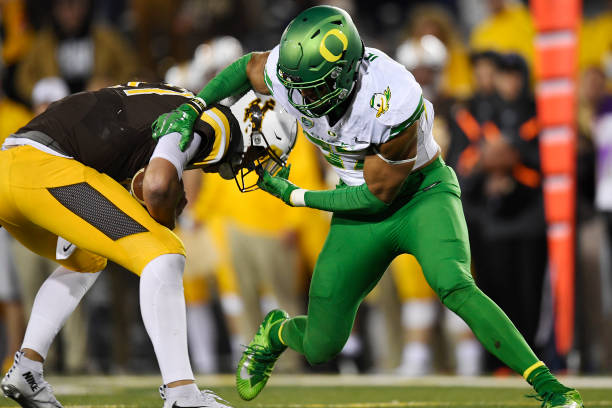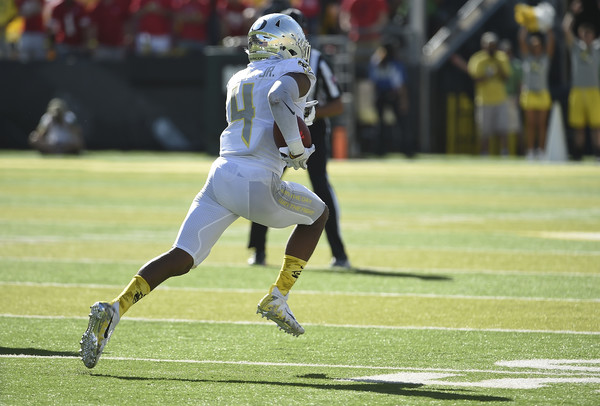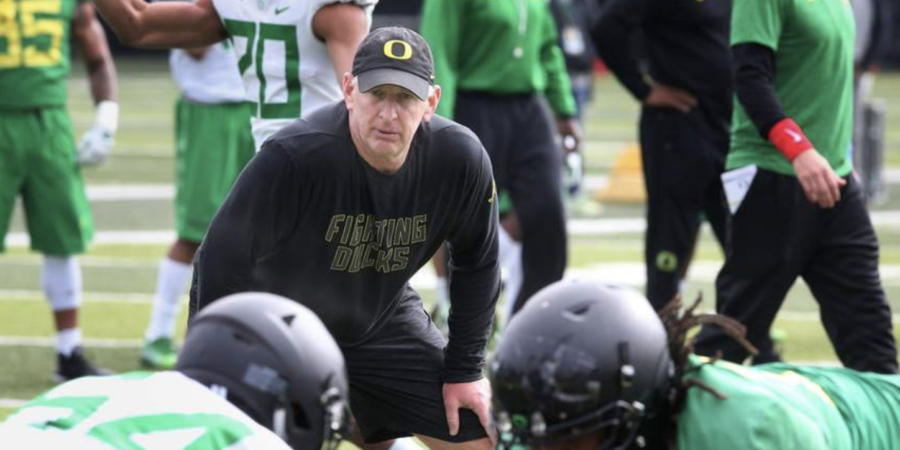Oregon defensive coordinator Jim Leavitt is a damn miracle worker.
In his first year directing the Duck defense, Leavitt not only drastically improved their performance in traditional statistical categories such as total defense (surrendering 518.4 yards/game in 2016 to 369.2 yards/game in 2017) and yards allowed per play (6.41 in ’16 to 5.07 in ’17), but also in advanced team defense metrics that more deeply convey the impact made.
For example, defensive success rate is a metric used to determine a defense’s overall effectiveness in limiting successful plays. Per Football Outsiders, defensive success is defined by a defense that limits an offense to: less than 50 percent of their necessary yardage on first down, less than 70 percent on second down, and less than 100 percent on third and fourth down. The Ducks ranked 21st nationally in this category last year compared to 120th nationally in 2016.
Havoc rate is another metric that combines a defense’s total tackles for loss, passes defensed, and forced fumbles divided by total plays. In 2016, the Ducks ranked 115th nationally in this category. In 2017, Oregon jumped nearly 100 spots, finishing the year ranked 19th in the country.
Jim Leavitt is a damn miracle worker.
However, while we know Leavitt was a smashing success in Year One, the question we ask is whether the talent is in place to sustain the marked improvement in Year Two. Today, we take a position-by-position look at the Oregon defense and evaluate whether the Ducks should expect more of the same in 2018.

Defensive Line:
Has Oregon improved?: It’s hard to say you’ve improved when you lose a valuable vet like Henry Mondeaux to graduation, but the Ducks could be equipped to hold serve here. Mondeaux’s five sacks and six tackles for loss (not to mention leadership) last season will be missed. The good news is that Oregon returns senior Jalen Jelks, who delivered a career year notching 6.5 sacks to lead all Oregon defenders. He also enters 2018 as the Pac-12’s reigning tackles for loss champ (15 TFLs in 2017) and as a potential early round draft pick next April. Jelks is joined upfront by two promising sophomores in Jordon Scott and Austin Faoliu. A Freshman All-American last season, Scott is an emotional leader at nose guard for the Oregon defense who quickly established himself as one of the unit’s – if not the team’s – most important players. Under-recruited despite hailing from high school powerhouse Mater Dei in Southern California, Faoliu – similar to Scott – also made a name for himself by providing steady play along the defensive line last year. He’ll be pushed this fall by redshirt junior Gary Baker, who by all accounts had himself a bit of a coming out party this past spring. Depth is where the concern lies with this group. Outside of Jelks, Scott, Faoliu, and perhaps Baker, the Ducks will be relying on the likes of Drayton Carlberg, Gus Cumberlander, and Popo Aumavae. None of which have played significant snaps, or in the case of Aumavae, any snaps at all. Additionally, the eligibility of guys like Malik Young and Miami (Fla.) transfer D.J. Johnson is unknown. Oregon will hope that JUCO transfer Sione Vea Kava and/or incoming freshman Andrew Faoliu (brother of Austin) can step up to provide some depth.
Linebacker:
Has Oregon improved?: Oh yeah. Not only does Oregon return one of the Pac-12’s best defensive players in junior Troy Dye, but they also bring back senior Justin Hollins and junior La’Mar Winston, who each enjoyed breakout seasons in 2017. There will be some production lost with the graduation of Jimmie Swain and Jonah Moi, and depth at outside linebacker takes a bit of a hit after the late Fotu Leiato was dismissed from the team in May. But the Ducks have unrealized talent waiting in the wings. If Dye, Hollins, and Winston are considered three of the defense’s headliners (which they are), then guys like Keith Simms, Isaac Slade-Matautia, Kaulana Apelu, and Bryson Young should be considered strong supporting role players. Apelu was a starter before suffering a season-ending ankle injury vs. Cal, and Simms and Slade-Matautia are two young players who enjoyed strong spring campaigns. Along with a healthy Apelu, both players could vie for a starting role this season. Young, a junior, received limited reps last season, but is a player who could see his play finally match his tremendous physique in 2018. Sophomore Sampson Niu is another potential up-and-comer who showed flashes of encouraging play before suffering an injury during the Las Vegas Bowl loss to Boise State. He missed the entire spring as he looks to be 100 percent come fall camp. Adrian Jackson, Andrew Johnson, and MJ Cunningham are true freshmen who could also provide stiff competition for second-team reps.

Cornerback:
Has Oregon improved?: Last year’s group of corners was probably better than this year’s. Gone is Arrion Springs who led both the Ducks, and the Pac-12, in passes defended last season (18). However, sophomores Thomas Graham and Deommodore Lenoir were highly-touted prep stars who are rapidly developing into all-conference caliber players. Graham, in particular, appears destined for stardom. After locking down the starting cornerback job opposite Springs early last fall, Graham tied for the team lead in interceptions (3) and finished third on the team in tackles (62). Along with Jordon Scott, he is a pillar that this defense can continue building around. Like the Duck defensive line, depth is a major concern for this unit. In fact, none of the players backing up Graham and Lenoir have ever taken a game rep as a Duck. Verone McKinley, a true freshman, arrived on campus this spring, as did JUCO transfer Haki Woods. They are expected to be the primary challengers behind Graham and Lenoir for playing time, but UNLV grad transfer Tim Hough and true freshman Kahlef Hailassie will have a say once fall camp begins. More so than perhaps any other unit outside of quarterback, this group will need to avoid injury and see at least one player from the group of McKinley, Woods, Hough, and Hailassie break out.
Safety:
Has Oregon improved?: Yes. Tyree Robinson has moved on after playing out what felt like a 12-year career in Eugene, but the rest of the group is back. After moving from corner to safety midway through last season, senior Ugo Amadi resides as the elder statesman and ringleader of the Oregon secondary. His versatility and leadership will once again be critical to Oregon’s efforts defending the pass this season. Mattrell McGraw, Brady Breeze, and Nick Pickett all played significant snaps last season and will be counted on again to be steadying influences in the back end of the defense. True freshmen Steve Stephens and Jevon Holland are two of the highest-rated safeties to ever commit to Oregon. Despite the competition that already exists ahead of them on the depth chart, both players have the athleticism and versatility to command consistent playing time this fall. This group is deep and filled with promise.
Have the Ducks improved on offense? Click HERE to read!

